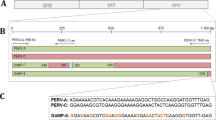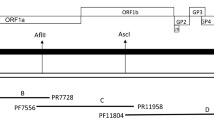Summary
A xenotropic Moloney murine leukemia virus-derived recombinant retrovirus (MMuLVSVnlslacZ) has been utilized to study the mechanism of virus entry into endothelial and epithelial porcine cells. In the genome of this recombinant retrovirus, thenlslacZ reporter gene is under the transcriptional control of both LTR and SV 40 early promoter. The entry of the retrovirus has been determined from the expression of this transduced reporter gene after its integration into the infected cells. This allows the detection of a very low level of viral infection and hence entry of the virus. Exposure of the virus-cell mixture to acidic pH (<6) during the early phase of interaction reduces the level of internalization. Cellular infection in presence of weak bases, ammonium chloride and amantadine and an ionophore monensin at concentrations sufficient to neutralize the endosomal pH does not modify the extent of viral entry into the cells. The results indicate that the entry of the recombinant retrovirus into porcine cells takes place by a pH-independent viral membrane-cell plasma membrane fusion mechanism.
Similar content being viewed by others
References
Alcami A, Carrascosa AL, Vinuela E (1989) The entry of African swine fever virus into Vero cells. Virology 171: 68–75
Andersen KB, Nexo BA (1983) Entry of murine retrovirus into mouse fibroblasts. Virology 125: 85–98
Bonnerot C, Rocancourt D, Briand P, Grimber G, Nicolas JF (1987) A β-galactosidase hybrid protein targeted to nuclei as a marker for developmental studies. Proc Natl Acad Sci USA 84: 6795–6799
Charreau B, Grepinet O, Delouis C, Nandi PK (1991) Establishment of porcine cell lines producing a murine recombinant retrovirus to transfer thenlslacZ gene in porcine cells. Res Virol 142: 343–351
Clapham PR, Nagy K, Cheinsong-Popov R, Exley M, Weiss RA (1983) Productive infection and cell-free transmission of human T-cell leukemia virus in a non-lymphoid cell line. Science 222: 1125–1127
Dales S (1973) Early events in cell virus interactions. Bacteriol Rev 37: 103–135
Davoust J, Grunberg J, Howell KE (1987) Two threshold values of low pH block endocytosis at different stages. EMBO J 6: 3601–3609
Delouis C, Milan D, L'Haridon R, Gianquinto L, Bonnerot C, Nicolas JF (1990) Xenotropic and amphotropic pseudotyped recombinant retrovirus to transfer genes into cells from various species. Biochem Biophys Res Comm 169: 1–14
Gimbrone MA, Fareed GC (1976) Transformation of cultured human endothelium by SV 40 DNA. Cell 9: 685–693
Helenius A, Marsh M, White J (1980) The entry of viruses into animal cells. Trends Biol Sci 104–106
Helenius A, Marsh M, White J (1982) Inhibition of Semliki Forest virus by lysosomotropic weak bases. J Gen Virol 58: 47–61
Koyama AH, Ushida T (1987) The mode of entry of Herpes simplex virus type 1 into vero cells. Microbiol Immunol 31: 123–130
Maddon PJ, Dalgleish AG, McDougal JS, Clapham PR, Weiss RA, Axel R (1986) The T 4 gene encodes the AIDS virus receptor and is expressed in the immune system and the brain. Cell 47: 333–338
Maddon PJ, McDougal JS, Clapham PR, Dalgleish AG, Jamal S, Weiss RA, Axel R (1988) HIV infection does not require endocytosis of its receptor CD 4. Cell 54: 865–874
Marsh M, Wellsteed J, Hildegard K, Harms E, Helenius A (1982) Monensin inhibits Semliki Forest virus penetration into culture cells. Proc Natl Acad Sci USA 79: 5297–5301
Marsh M (1984) The entry of enveloped viruses into cells by endocytosis. Biochem J 218: 1–10
Marsh M, Helenius A (1984) Endocytosis and penetration of Semliki Forest virus. In: Dingle JT, Dean RT, Sly W (eds) Lysosomes in biology and pathology. Elsevier, Amsterdam, pp 297–313
Marsh M, Helenius A (1989) Virus entry into animal cells. Adv Virus Res 36: 107–151
McClure MO, Marsh M, Weiss RA (1988) Human immunodeficiency virus infection of CD 4-bearing cells occurs by a pH-independent mechanism. EMBO J 7: 513–518
McClure MO, Sommerfelt MA, Marsh M, Weiss RA (1990) The pH independence of mammalian retrovirus infection. J Gen Virol 71: 767–773
McClurkin AW, Norman JO (1966) Studies on gastroenteritis of swine: II — Selected characteristic of a cytopathogenic virus to five isolated from transmissible gastroenteritis. Can J Comp Med Sci 30: 190–198
Nabel EG, Plautz G, Boyce FM, Stanley JC, Nabel GJ (1989) Recombinant gene expression in vivo within endothelial cells of the arterial wall. Science 244: 1342–1344
Patterson S, Oxford JS, (1986) Early interactions between animal viruses and the host cell: relevance to viral vaccines. Vaccine 4: 79–90
Portis JL, McAtee FJ, Evans LH (1985) Infectious entry of murine retroviruses into mouse cells: evidence of a postadsorption step inhibited by acidic pH. J Virol 55: 806–812
Redmond S, Peters G, Dickson C (1984) Mouse mammary tumour virus can mediate cell fusion at reduced pH. Virology 133: 393–402
Sandvig K, Olsner S, Peterson OW, Van Deurs (1987) Acidification of the cytosol inhibits endocytosis from coated pits. J Cell Biol 105: 679–689
Sanes JR, Rubenstein JLR, Nicolas JF (1986) Use of a recombinant retrovirus to study post-implantation cell lineage in mouse embryo. EMBO J 5: 3133–3142
Schlegel R, Dickson RB, Willigham MC, Pastan IH (1982) Amantadine and dansyl-cadaverine inhibit vesicular stomatitis virus uptake and receptor-mediated endocytosis of α 2-macroglobulin. Proc Natl Acad Sci USA 79: 2291–2295
Shimura H, Umeno Y, Kimura G (1987) Effects of inhibitors of the cytoplasmic structures and functions on the early phase of infection of cultured cells with simian virus 40. Virology 158: 34–43
Sladek TL, Jacobberger JW (1990) Rapid titration of retroviral vectors encoding intracellular antigens by flow cytometry. J Gen Virol 64: 3135–3138
Spear PG, Wittels M, Wudunn D, Johnson R (1988) Herpes simplex virus: entry into and egress from the cell. J Cell Biochem [Suppl] 12c: 13
Springett GM, Moen RC, Anderson S, Blaese RM, Anderson WF (1989) Infection efficiency of T lymphocytes with amphotropic retroviral vectors is cell cycle dependent. J Virol 63: 3865–3869
Stein BS, Gowda SD, Lifson JD, Penhallow RC, Bensch KG, Engleman EG (1987) PH-independent HIV entry into CD 4 positive T cells via virus envelope fusion to the plasma membrane. Cell 49: 659–668
Timar J, Nagy K, Robertson D, Clapham P, Weiss RA (1987) Ultrastructure and immunoelectron microscopy of human T-cell leukemia virus type I-producing lymphoid and non-lymphoid human tumour cells. J Gen Virol 68: 1011–1020
Voyta JC, Butterfield CE, Zetter BR (1984) Identification and isolation of endothelial cells based on their increased uptake of acetyled low density lipoprotein. J Cell Biol 99: 2034–2040
White J, Kielian M, Helenius A (1983) Membrane fusion proteins of enveloped animal viruses. Q Rev Biophys 16: 151–195
Zwiebel JA, Freeman SM, Kantoff PW, Cornetta K, Ryan US, Anderson WF (1989) High level recombinant gene expression in rabbit endothelial cells transduced by retroviral vectors. Science 243: 220–222
Author information
Authors and Affiliations
Rights and permissions
About this article
Cite this article
Gilbert, M.A., Charreau, B., Vicart, P. et al. Mechanism of entry of a xenotropic MMuLV-derived recombinant retrovirus into porcine cells using the expression of the reporternlslacZ gene. Archives of Virology 124, 57–67 (1992). https://doi.org/10.1007/BF01314625
Received:
Accepted:
Issue Date:
DOI: https://doi.org/10.1007/BF01314625




